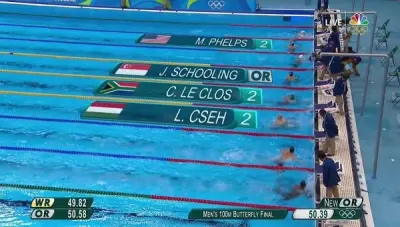
Those following the Summer Olympics in Rio likely noticed the proliferation of ties in the swimming pool.
On Thursday, American Simone Manuel tied with Canadian Penny Oleksiak for the gold medal in the 100m freestyle. In the men’s 100m butterfly on Friday, Michael Phelps, Chad le Clos and Laszlo Cseh all tied for second and took home silver medals.
Given that timing systems allow us to measure time to the thousandth or millionth of a second, why aren’t they used to break ties in the swimming pool? Well, as Deadspin’s Timothy Burke explained, it’s all due to an issue of engineering.
Here’s Burke explaining the issue:
In a 50 meter Olympic pool, at the current men’s world record 50m pace, a thousandth-of-a-second constitutes 2.39 millimeters of travel. FINA pool dimension regulations allow a tolerance of 3 centimeters in each lane, more than ten times that amount. Could you time swimmers to a thousandth-of-a-second? Sure, but you couldn’t guarantee the winning swimmer didn’t have a thousandth-of-a-second-shorter course to swim.
That actually makes plenty of sense.
Translation, they could actually time the swimmers to the thousandth of a second to break ties but they don’t because they’re allowing for a potential engineering difference in the length of each swimming lane.
In 1972, American Tim McKee actually tied with Swedish swimmer Gunnar Larsson in the 400m individual medley, but officials decided to go to the thousandth of a second to break the tie. That gave Larsson the gold and McKee the silver. After that controversy, swimming decided to just stop at the hundredth of a second to measure times.
Seeing competitors tie may be unsatisfying for some viewers, but rounding off the times after two decimal places may be the fairest way to treat things. We sure as heck know that this swimmer isn’t complaining about it.


